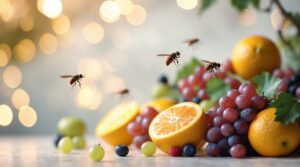Fruit flies are the uninvited guests no one wants. They swarm in kitchens, hover over compost bins, and seem to appear out of nowhere, turning your peaceful home or flourishing garden into a battleground. If you’ve ever had to deal with fruit flies, you know how persistent and annoying they can be. But understanding their habits, dispelling common myths, and taking environmentally-friendly actions can make all the difference.
This guide will walk you through everything you need to know about fruit flies why they’re such a nuisance, how to get rid of them effectively, and how to ensure they don’t stage a comeback. By the end, you’ll feel confident in taking charge of your home and garden again.

Understanding the Life Cycle and Behavior of Fruit Flies
To eliminate fruit flies for good, you first need to understand what makes them tick. Fruit flies (scientifically known as Drosophila) are incredibly small, usually only about 1/8 of an inch long. What they lack in size, however, they make up for in speed reproducing at an alarming rate.
Life Cycle of a Fruit Fly:
- Egg Stage: Female fruit flies lay their eggs on ripened or rotting fruits, leftover food, or damp organic matter. One female can lay up to 500 eggs, which hatch within 24 to 48 hours.
- Larvae Stage: After hatching, larvae burrow into the food source for nourishment.
- Pupae Stage: Within a few days, larvae become pupae, and soon after, emerge as fully-grown adult fruit flies.
- Adult Stage: Adults are sexually mature within 12 hours of emerging from their pupal stage, which allows the cycle to repeat rapidly.
Because of this quick cycle, ignoring the problem—even for a short while—can result in an infestation.
Where Do They Thrive?
Fruit flies are particularly drawn to sweet, fermenting fruits and vegetables, sugary liquids, and moist organic material. They also thrive in drains, garbage disposals, recycling bins, and compost heaps. These environments provide the perfect breeding ground for their rapid reproduction.
Common Misconceptions About Fruit Fly Prevention and Control
Before tackling the issue head-on, it’s important to separate fact from fiction. Misconceptions about fruit flies often lead to wasted effort and frustration.
Misconception 1: Fruit Flies Only Come From Fruit
While their name suggests otherwise, fruit flies don’t only rely on fruit to survive. They’ll breed on any organic surface rich in moisture and sugar—like drains, soggy dishcloths, or even empty bottles with sugary residue.
Misconception 2: You Can Get Rid of Them by Washing Produce
Washing fruits and vegetables removes some eggs or flies, but it won’t solve the problem entirely. Adult fruit flies may still be living in drains or hidden trash areas. A comprehensive approach is necessary.
Misconception 3: Chemical Sprays Are the Best Solution
Chemical insecticides might seem like an easy way to get rid of fruit flies, but they only kill active adults and don’t address breeding grounds. Plus, they introduce toxic chemicals into your home environment—something environmentally conscious households strive to avoid.
Environmentally-Friendly and Non-Toxic Methods for Getting Rid of Fruit Flies
For those leaning toward safer and greener solutions, here are tried-and-tested methods that align with eco-friendly values:
1. Apple Cider Vinegar Traps
Fill a small bowl or jar with apple cider vinegar and a few drops of dish soap. The vinegar attracts the fruit flies, while the dish soap breaks the liquid’s surface tension, causing them to drown.
2. DIY Paper Cone Trap
Place a small piece of ripe fruit at the bottom of a jar. Roll a piece of paper into a funnel shape and secure it so the narrow end faces inside the jar. Flies can enter but struggle to escape.
3. Clean Drains with Boiling Water or Baking Soda Mix
Pour boiling water or a mixture of baking soda and vinegar down drains to kill larvae and clear residue. This eliminates one of their most common breeding spots.
4. Clove-Scented Repellant
Place lemons studded with whole cloves on your countertops. While fruit flies are attracted to the citrus smell, they detest cloves, making this an effective and natural deterrent.
5. Regular Compost and Trash Maintenance
Empty your compost bin daily and rinse it with soapy water to remove sticky organic matter. The same goes for trash cans or recycling bins where residues might linger.
Practical Steps to Prevent Future Fruit Fly Infestations
Now that you’ve tackled the current problem, prevention is key to ensuring fruit flies never return.
1. Store Produce Properly
Place ripe fruits and vegetables in the refrigerator rather than on countertops. This makes it harder for fruit flies to access their ideal breeding environment.
2. Maintain a Clean Kitchen
Wipe down counters daily, routinely clean underneath appliances, and check for unnoticed spills or food scraps. Never leave dirty dishes in the sink overnight.
3. Seal Trash and Recycling Bins
Use bins with tightly sealed lids, and line them with bags to limit access to organic residue.
4. Inspect Incoming Produce
Wash fresh produce immediately after buying it to remove any eggs before bringing it into your home.
5. Fix Leaky Faucets or Drains
Moist environments are a fruit fly’s paradise. Fix any leaks and keep sink areas dry to prevent breeding.
Real-Life Success Stories

for more article click here
Sarah’s Compost Solution
Sarah, an avid gardener, noticed fruit flies swarming her compost bin. By adopting a layered composting approach (adding dry, carbon-rich materials on top of wet food scraps), she drastically reduced the problem within weeks.
Jake’s Kitchen Overhaul
Jake struggled with recurring fruit fly problems until he deep-cleaned his kitchen, including his drains and under-appliances. He now swears by the apple cider vinegar trap as his first line of defense.
Maria’s Natural Deterrents
Maria used clove-studded lemons in every corner and found they significantly reduced the presence of fruit flies in her home. She’s since added this strategy to her routine during the warmer months.
Share Your Own Solutions and Questions!
Have you had success with getting rid of fruit flies? Did you try any of the methods we talked about? Or do you still have questions about dealing with a unique fruit fly issue in your home or garden? Leave a comment or share your tips below we’d love to hear from you.
If you’re interested in learning more environmentally-friendly pest control techniques, stay tuned for future posts. Together, we can keep our homes and gardens harmonious spaces, free from unwanted pests.











